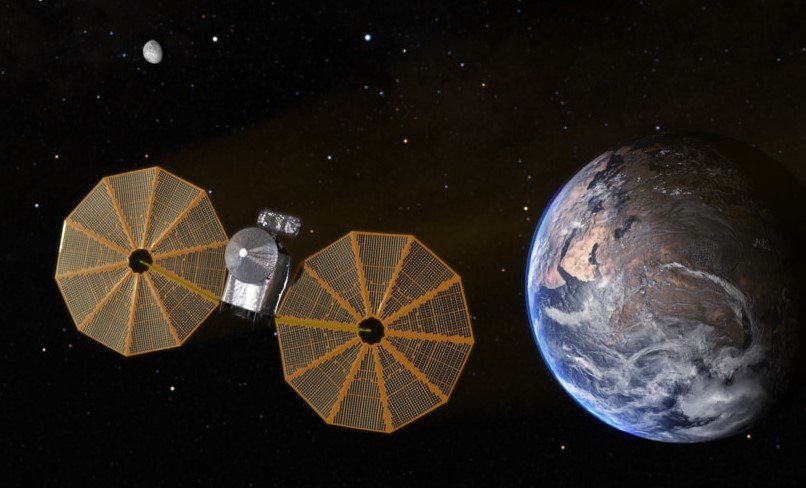At 170 feet wide and moving at over 77,000 km/h, the asteroid will fly by millions of kilometers away — still close enough to keep space scientists on alert
An asteroid the size of a commercial jet is speeding toward Earth’s neighborhood today, but there’s no need to panic. NASA says the object, named 2025 OT7, will safely zoom past our planet — no impact, no explosion, and absolutely no Bruce Willis-style intervention required.
It’s expected to pass about 4.3 million kilometers away, which, in cosmic terms, counts as “close.” But to be clear, it’s still more than 11 times the distance between Earth and the Moon.
No Threat, Just a Reminder of Our Fragile Neighborhood
Asteroid flybys like this happen more often than most people think. But each one — even the harmless ones — gets serious attention from space agencies.
OT7 isn’t classified as dangerous. Yet, its size (about 170 feet or ~52 meters) and speed (roughly 77,942 km/h) make it worth monitoring. It belongs to the Aten group of asteroids, which means its orbit brings it inside Earth’s path around the Sun — often crossing it.
That’s why NASA’s Jet Propulsion Laboratory and other planetary defense teams aren’t brushing it off.
They’ve tracked its trajectory down to fractions of a degree, and unless gravity suddenly pulls a wild card, this asteroid is just swinging by for a brief cosmic hello.

Why Track a Space Rock With No Chance of Collision?
Because things change. Orbits wobble. Gravity nudges. Space, for all its vast emptiness, is full of surprises.
Even a small deviation — caused by something like Earth’s gravity, or even sunlight bouncing unevenly off the asteroid’s surface (yes, that’s called the Yarkovsky effect) — can shift the path over time.
Which is why scientists stay on high alert.
One planetary scientist from ISRO’s tracking team summed it up: “Think of it like weather monitoring. You don’t ignore the sunny days — you study them to prepare for the storms.”
Here’s why flybys like this still matter:
-
They help refine asteroid orbits using radar and optical observations.
-
They provide real-time tests of early warning systems.
-
They serve as practice runs for planetary defense strategies.
-
They remind the public that asteroid defense is real — not just Hollywood.
NASA’s Watchlist: Size, Distance, and the “Hazard” Threshold
NASA has a specific checklist to label something as potentially hazardous. It’s not based on panic — it’s data-driven:
-
Any asteroid larger than 85 meters (~280 feet) in diameter
-
And passing within 7.4 million kilometers of Earth
So OT7? Not big enough. Not close enough. It doesn’t even make the list.
Still, at 170 feet wide — about the length of a Boeing 737 — it would do serious damage if it ever entered Earth’s atmosphere. That’s why scientists pay attention even when the risks are low.
One sentence says it all: Close doesn’t mean dangerous, but it means worth watching.
Past Encounters and What We’ve Learned
This isn’t the first time we’ve had a near-ish miss. Earth gets dozens of these each year, but a few recent ones stood out:
| Year | Asteroid Name | Closest Distance | Size (Approx) |
|---|---|---|---|
| 2019 | 2019 OK | 72,000 km | 100 meters |
| 2023 | 2023 BU | 3,600 km | 4 meters |
| 2024 | 2024 QW1 | 1.2 million km | 150 meters |
| 2025 | 2025 OT7 | 4.3 million km | 52 meters |
The closest flyby on record — 2023 BU — came just 3,600 km from Earth. That’s closer than some satellites. It burned up in the atmosphere, but it was a wake-up call.
NASA and ESA (European Space Agency) have since accelerated their planetary defense programs, including missions like DART (which successfully nudged an asteroid in 2022) and the upcoming Hera mission for follow-up analysis.
So, What If OT7 Was on a Collision Course?
Just for context — it’s not — but let’s say it were. What could happen?
A 170-foot asteroid hitting Earth wouldn’t end civilization, but it would wipe out a city the size of Lucknow or St. Louis. We’re talking a regional disaster, not a global one.
That’s why simulations, early detection, and even potential deflection strategies are so crucial.
In a hypothetical collision scenario, these would be the priorities:
-
Evacuation zones based on projected impact path
-
Emergency response coordination with global space agencies
-
Use of deflection technology (missiles, gravity tractors, or kinetic impactors)
But again, OT7 is not a threat. It’s an opportunity — a dry run for the real deal someday.
Today’s Flyby: When and Where to Watch?
Sadly, you won’t be able to spot it with the naked eye. OT7 is just too small and too far for backyard telescopes to get a look.
Still, several observatories — including NASA’s Goldstone radar and European networks — will be live-tracking the event for research and public data logs.
Timing-wise, the closest approach is expected late evening IST on August 5. No visible flash, no sound, no trail — just a silent traveler passing through.
